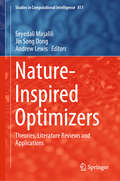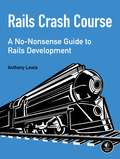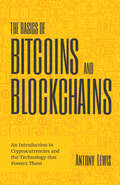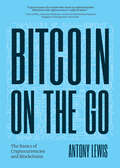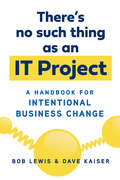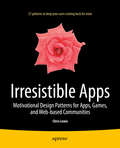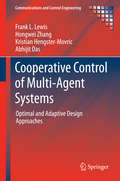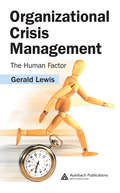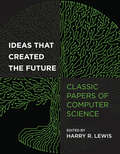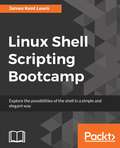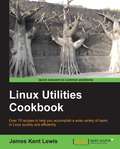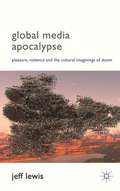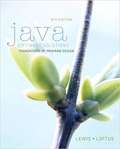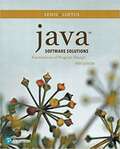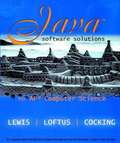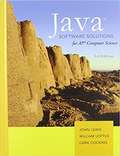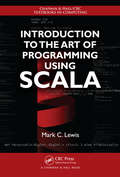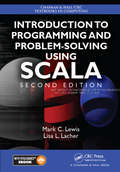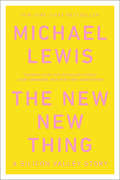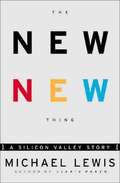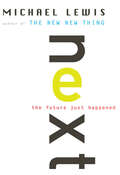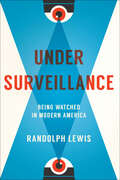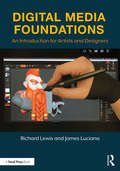- Table View
- List View
Nature-Inspired Optimizers: Theories, Literature Reviews and Applications (Studies in Computational Intelligence #811)
by Andrew Lewis Jin Song Dong Seyedali MirjaliliThis book covers the conventional and most recent theories and applications in the area of evolutionary algorithms, swarm intelligence, and meta-heuristics. Each chapter offers a comprehensive description of a specific algorithm, from the mathematical model to its practical application. Different kind of optimization problems are solved in this book, including those related to path planning, image processing, hand gesture detection, among others. All in all, the book offers a tutorial on how to design, adapt, and evaluate evolutionary algorithms. Source codes for most of the proposed techniques have been included as supplementary materials on a dedicated webpage.
Rails Crash Course: A No-Nonsense Guide to Rails Development
by Anthony LewisRails is a robust, flexible development platform that lets you build complex websites quickly. Major websites like GitHub, Hulu, and Twitter have run Rails under the hood, and if you know just enough HTML and CSS to be dangerous, Rails Crash Course will teach you to harness Rails for your own projects and create web applications that are fast, stable, and secure.In Part I, you’ll learn Ruby and Rails fundamentals and then dive straight into models, controllers, views, and deployment. As you work through the basics, you’ll learn how to:–Craft persistent models with Active Record–Build view templates with Embedded Ruby–Use Git to roll back to previous versions of your code base–Deploy applications to HerokuIn Part II, you’ll take your skills to the next level as you build a social networking app with more advanced Ruby tools, such as modules and metaprogramming, and advanced data modeling techniques within Rails’s Active Record. You’ll learn how to:–Implement an authentication system to identify authorized users–Write your own automated tests and refactor your code with confidence–Maximize performance with the asset pipeline and turbolinks–Secure your app against SQL injection and cross-site scripting–Set up a server and deploy applications with CapistranoEach chapter is packed with hands-on examples and exercises to reinforce what you’ve learned. Whether you’re completely new to Ruby or you’ve been mucking around for a bit, Rails Crash Course will take you from the basics to shipping your first Rails application, fast.
The Basics of Bitcoins and Blockchains: An Introduction to Cryptocurrencies and the Technology that Powers Them
by Antony LewisDiscover the Surprising History of Ordinary Things"Emily magically weaves a vibrant history of simple everyday objects we often take for granted. The Story Behind will surprise and delight..." ─Deana Marie, Creator & Host of the Twisted Philly podcast#1 Best Seller in Trivia & Fun Facts, Art History, Design History & Criticism, Reference, Decorative Arts & Design, and History of TechnologyLearn the fascinating history and trivia you never knew about things we use daily, from the host of The Story Behind podcast.Everyday objects and major events in history. Every single thing that surrounds us has a story behind it. Many of us learn the history of humans and the major inventions that shaped our world. But what you may not have learned is the history of objects we surround ourselves with every day. You might not even know how the major events in history (World Wars, ancient civilizations, revolutions, etc.) influenced the inventions of things we use today.The history and science behind the ordinary. From the creator of The Story Behind podcast comes one of the coolest coffee table books ever written. The Story Behind provides insight into everyday objects we don’t think much about as we use them. Topics covered in Emily’s podcast are examined in more detail along with new fascinating topics. Learn how lollipops got started in Ancient Egypt, how podcasts were invented, and why Comic Sans was created. Learn the torture device origins of certain exercise equipment and the espionage beginnings of certain musical instruments. Ordinary things from science to art, food to sports, customs to fashion, and more are explored.Inside:Learn obscure history and fun facts and change the way you see the worldDiscover how major historic events still affect us todayBecome a formidable trivia masterIf you have enjoyed books such as Now I Know, What If?, Ever Wonder Why?, The Greatest Stories Never Told, or Atlas Obscura; you will be entertained by The Story Behind.
Bitcoin on the Go: The Basics of Bitcoins and Blockchains
by Antony LewisA Condensed Guide to Understanding Bitcoin, Blockchains, and Cryptocurrency“One of the few credible books I suggest when people ask ‘where can I learn about bitcoin?’―Zennon Kapron, Managing Director, Kapronasia (Review of The Basics of Bitcoins and Blockchains)You’re an active, on-the-go person and need a condensed version of the Antony Lewis best-selling The Basics of Bitcoins and Blockchains? Now Bitcoin on the Go offers the same clear guide to this new currency and the revolutionary technology that powers it―just in a condensed format.Bitcoin, Ethereum, and other cryptocurrencies. Gain an understanding of a broad spectrum of Bitcoin topics including the history of Bitcoin, the Bitcoin blockchain, and Bitcoin buying, selling, and mining. Learn how payments are made, and how to put a value on cryptocurrencies and digital tokens.Blockchain technology. What exactly is a blockchain, how does it work, and why is it important? Bitcoin on the Go answers these questions and more. Learn about notable blockchain platforms, smart contracts, and other important facets of blockchains and their function in the changing cyber-economy.Things to know before buying cryptocurrencies. Find trustworthy and balanced insights into Bitcoin investing and investing in other cryptocurrencies. Discover the risks and mitigations, learn how to identify scams, and understand cryptocurrency exchanges, digital wallets, and regulations.Learn about:Blockchain technology and how it worksWorkings of the cryptocurrency marketEvolution and potential impacts of Bitcoin and blockchains on global businessesYou’ve read The Bitcoin Standard, Blockchain Bubble or Revolution, the full version of The Basics of Bitcoins and Blockchains by Antony Lewis, or The Only Cryptocurrency Investing Book You'll Ever Need but you want to understand this new currency in a quick easy-to-read format. Pick up a copy of Bitcoin on the Go.
There's No Such Thing as an IT Project: A Handbook for Intentional Business Change
by Bob Lewis Dave KaiserLearn how to stop pouring vast sums of money into technology projects that don't have a lasting impact by closing the communication gap between IT and leadership.Too many businesses miss opportunity after opportunity to design, plan, and achieve intentional business change. Why? Because they charter projects focused on delivering software products: IT projects. But as this groundbreaking book points out, there's no such thing as an IT project—or at least there shouldn't be. It's always about intentional business change, or what's the point?It's time to stop providing simplistic, one-dimensional, all-you-gotta-do panaceas. When the only constant in business is change, truly useful IT has to help you change instead of build solutions that are obsolete even before they are completed. IT consultant Bob Lewis, author of the bestselling Bare Bones Project Management, has joined forces with seasoned CIO Dave Kaiser to give you the tools you need. It's a multidimensional, relentlessly practical guide. Condensed to handbook length and seasoned with Lewis's trademark sardonic humor, it's an enjoyable and digestible read as well.Lewis and Kaiser take you step by step through the process of building a collaboration between IT and the rest of the business that really works. Insisting on intentional business change takes patience, communication, and courage, but it has a huge payoff. More to the point, insist on anything else and every penny you spend will be a wasted dime and a waste of time.
Irresistible Apps
by Chris LewisThis practical guide provides a comprehensive overview of professionally managed assets, or investments in which all portfolio decisions and rebalancing are delegated to a fund manager or third-party advice service. Savvy investors looking to achieve a better understanding of the nuances, benefits, and drawbacks of using these products?will find the answers they are looking for in?The Handbook of Professionally Managed Assets, ?no matter whether they would like to learn more about mutual funds or hedge funds. There is a considerable lack of knowledge among the investing public about how to properly construct a well-diversified portfolio of investments that includes a selection of professionally managed assets. As a long-standing financial planner, attorney, and educator, Keith Fevurly remedies this issue in The Handbook of Professionally Managed Assets?by clearly presenting the major categories of professionally managed assets and revealing the best tactics for investing in these vehicles. Along the way, he reveals each asset''s risks and rewards, and he also provides the in-depth knowledge and information investors need to confidently select the right assets for their portfolios. Filled with valuable insights for everyone from financial professionals to individual investors, The Handbook of Professionally Managed Assets?stands alone in its ability to shed light on the many investment vehicles that fall under the larger umbrella of professionally managed assets. With topics as wide-ranging as mutual funds, closed-end funds, unit investment trusts, exchange traded funds, hedge funds, managed futures, and more, this invaluable resource will give you the information you need to build a prosperous financial future for yourself and your clients.
Cooperative Control of Multi-Agent Systems: Optimal and Adaptive Design Approaches (Communications and Control Engineering)
by Frank L. Lewis Abhijit Das Hongwei Zhang Kristian Hengster-MovricCooperative Control of Multi-Agent Systems extends optimal control and adaptive control design methods to multi-agent systems on communication graphs. It develops Riccati design techniques for general linear dynamics for cooperative state feedback design, cooperative observer design, and cooperative dynamic output feedback design. Both continuous-time and discrete-time dynamical multi-agent systems are treated. Optimal cooperative control is introduced and neural adaptive design techniques for multi-agent nonlinear systems with unknown dynamics, which are rarely treated in literature are developed. Results spanning systems with first-, second- and on up to general high-order nonlinear dynamics are presented. Each control methodology proposed is developed by rigorous proofs. All algorithms are justified by simulation examples. The text is self-contained and will serve as an excellent comprehensive source of information for researchers and graduate students working with multi-agent systems.
Organizational Crisis Management: The Human Factor
by Gerald LewisOrganizational Crisis Management: The Human Factor offers theoretical background and practical strategies for responding to workplace crises. Responding to a paradigm that focuses on the operational aspects of continuity to the detriment of human factors, this volume provides a comprehensive understanding of the unavoidable yet often complex reacti
Ideas That Created the Future: Classic Papers of Computer Science
by Harry R. LewisClassic papers by thinkers ranging from from Aristotle and Leibniz to Norbert Wiener and Gordon Moore that chart the evolution of computer science.Ideas That Created the Future collects forty-six classic papers in computer science that map the evolution of the field. It covers all aspects of computer science: theory and practice, architectures and algorithms, and logic and software systems, with an emphasis on the period of 1936-1980 but also including important early work. Offering papers by thinkers ranging from Aristotle and Leibniz to Alan Turing and Nobert Wiener, the book documents the discoveries and inventions that created today's digital world. Each paper is accompanied by a brief essay by Harry Lewis, the volume's editor, offering historical and intellectual context.
Linux Shell Scripting Bootcamp
by James Kent LewisA quick and straightforward approach to writing shell scripts to accomplish different types of tasks on a Linux system. About This Book • Understand expressions and variables and how to use them practically • Familiarize yourself with the various text filtering tools available in Linux • A fast-paced and concise guide that gets you well versed with linux shell scripting. Who This Book Is For This book is for both GNU/Linux users who want to do amazing things with the shell and for advanced users looking for ways to make their lives with the shell more productive. What You Will Learn • Get acquainted with the basics of a shell script to serve as a refresher for more advanced topics • Learn different ways to create and run a script • Discuss the passing and verification of parameters, along with the verification of other items. • Understand the different forms of conditions and loops, and go over the sleep command in detail • Learn about different ways to handle the reporting of return codes • Create an interactive script by reading the keyboard and use subroutines and interrupts • Create scripts to perform backups and go over the use of encryption tools and checksums • Use wget and curl in scripts to get data directly from the Internet In Detail Linux Shell Scripting Bootcamp is all about learning the essentials of script creation, validating parameters, and checking for the existence of files and other items needed by the script. We will use scripts to explore iterative operations using loops and learn different types of loop statements, with their differences. Along with this, we will also create a numbered backup script for backup files. Further, you will get well-versed with how variables work on a Linux system and how they relate to scripts. You'll also learn how to create and call subroutines in a script and create interactive scripts. The most important archive commands, zip and tar, are also discussed for performing backups. Later, you will dive deeper by understanding the use of wget and curl scripts and the use of checksum and file encryption in further chapters. Finally, you will learn how to debug scripts and scripting best practices that will enable you to write a great code every time! By the end of the book, you will be able to write shell scripts that can dig data from the web and process it efficiently. Style and approach This book is all about fast and intensive learning. This means we don't waste time in helping readers get started. The new content is basically about filling in with highly-effective examples to build new things, solving problems in newer and unseen ways, and solving real-world examples.
Linux Utilities Cookbook
by James Kent LewisA Cookbook-style guide packed with examples and illustrations, it offers organized learning through recipes and step-by-step instructions. The book is designed so that you can pick exactly what you need, when you need it.Written for anyone that would like to familiarize themselves with Linux. This book is perfect migrating from Windows to Linux and will save your time and money, learn exactly how to and where to begin working with Linux and troubleshooting in easy steps.
Global Media Apocalypse
by Jeff LewisThe modern world seems trapped between fantasies of infinite pleasure and the prospects of total global catastrophe. Global Media Apocalypse explores these contrary imaginings through an evolving cultural ecology of violence. Articulated through the global media, these apocalyptic fantasies express a profoundly human condition of crisis.
Java Software Solutions
by John Lewis William LoftusJava Software Solutions teaches a foundation of programming techniques to foster well-designed object-oriented software. Heralded for its integration of small and large realistic examples, this worldwide best-selling text emphasizes building solid problem-solving and design skills to write high-quality programs.
Java Software Solutions
by John Lewis William LoftusJava Software Solutions establishes a strong foundation of programming techniques to foster well-designed object-oriented software. Heralded for its integration of small and large real-world examples, the worldwide best-selling text emphasizes problem-solving and design skills and introduces students to the process of constructing high-quality software systems. <p><p>The 9th Edition features a sweeping overhaul of Graphics Track coverage, to fully embrace the JavaFX API. This fresh approach enriches programmers’ understandings of core object-oriented principles. The text uses a natural progression of concepts, focusing on the use of objects before teaching how to write them–equipping students with the knowledge and skill they need to design true object-oriented solutions.
Java Software Solutions for AP Computer Science: Foundations for Program Design
by John Lewis William Loftus Cara CockingSpecifically designed for beginning programmers, this Advanced Placement book matches the AP Computer Science topic outline and Java subset set forth by the College Board.
Java Software Solutions for AP Computer Science A (2nd edition)
by John Lewis William Loftus Cara CockingThis edition was developed to include features of the Java 2 Standard Edition 5.0, known as Java 5, which will be used on the AP Computer Science Exam. It retains all the pedagogy and attention to detail that made the first edition successful.
Java Software Solutions for AP Computer Science
by John Lewis William Loftus Cara Cocking Susan HorwitzJava Software Solutions for AP Computer Science Third Edition by Susan Horwitz, Cara Cocking, William Loftus, and John Lewis.
Introduction to the Art of Programming Using Scala (Chapman And Hall/crc Textbooks In Computing Ser.)
by Mark C. LewisWith its flexibility for programming both small and large projects, Scala is an ideal language for teaching beginning programming. Yet there are no textbooks on Scala currently available for the CS1/CS2 levels. Introduction to the Art of Programming Using Scala presents many concepts from CS1 and CS2 using a modern, JVM-based language that works we
Introduction to Programming and Problem-Solving Using Scala (Chapman & Hall/CRC Textbooks in Computing)
by Mark C. Lewis Lisa LacherPraise for the first edition: "The well-written, comprehensive book…[is] aiming to become a de facto reference for the language and its features and capabilities. The pace is appropriate for beginners; programming concepts are introduced progressively through a range of examples and then used as tools for building applications in various domains, including sophisticated data structures and algorithms…Highly recommended. Students of all levels, faculty, and professionals/practitioners.—D. Papamichail, University of Miami in CHOICE Magazine Mark Lewis’ Introduction to the Art of Programming Using Scala was the first textbook to use Scala for introductory CS courses. Fully revised and expanded, the new edition of this popular text has been divided into two books. Introduction to Programming and Problem-Solving Using Scala is designed to be used in first semester college classrooms to teach students beginning programming with Scala. The book focuses on the key topics students need to know in an introductory course, while also highlighting the features that make Scala a great programming language to learn. The book is filled with end-of-chapter projects and exercises, and the authors have also posted a number of different supplements on the book website. Video lectures for each chapter in the book are also available on YouTube. The videos show construction of code from the ground up and this type of "live coding" is invaluable for learning to program, as it allows students into the mind of a more experienced programmer, where they can see the thought processes associated with the development of the code. About the Authors Mark Lewis is a Professor at Trinity University. He teaches a number of different courses, spanning from first semester introductory courses to advanced seminars. His research interests included simulations and modeling, programming languages, and numerical modeling of rings around planets with nearby moons. Lisa Lacher is an Assistant Professor at the University of Houston, Clear Lake with over 25 years of professional software development experience. She teaches a number of different courses spanning from first semester introductory courses to graduate level courses. Her research interests include Computer Science Education, Agile Software Development, Human Computer Interaction and Usability Engineering, as well as Measurement and Empirical Software Engineering.
The New New Thing: A Silicon Valley Story
by Michael LewisNew York Times Bestseller. "A superb book. . . . [Lewis] makes Silicon Valley as thrilling and intelligible as he made Wall Street in his best-selling Liar's Poker."--Time In the weird glow of the dying millennium, Michael Lewis set out on a safari through Silicon Valley to find the world's most important technology entrepreneur. He found this in Jim Clark, a man whose achievements include the founding of three separate billion-dollar companies. Lewis also found much more, and the result--the best-selling book The New New Thing--is an ingeniously conceived history of the Internet revolution.
The New New Thing: A Silicon Valley Story
by Michael LewisA biography of the founder of Netscape serves as a illustration of the profound changes in the 1980s due to the Internet.
Next: The Future Just Happened
by Michael LewisThe New York Times bestseller. "His book is a wake-up call at a time when many believe the net was a flash in the pan."--BusinessWeek With his knowing eye and wicked pen, Michael Lewis reveals how the Internet boom has encouraged changes in the way we live, work, and think. In the midst of one of the greatest status revolutions in the history of the world, the Internet has become a weapon in the hands of revolutionaries. Old priesthoods are crumbling. In the new order, the amateur is king: fourteen-year-olds manipulate the stock market and nineteen-year-olds take down the music industry. Unseen forces undermine all forms of collectivism, from the family to the mass market: one black box has the power to end television as we know it, and another one may dictate significant changes in our practice of democracy. With a new afterword by the author.
Under Surveillance: Being Watched in Modern America
by Randolph Lewis&“An engaging, alarming, and enlightening book, one that is certain to be among the most important books on surveillance in the twenty-first century.&” —Siva Vaidhyanathan, author of Antisocial Media Never before has so much been known about so many. CCTV cameras, TSA scanners, NSA databases, big data marketers, predator drones, &“stop and frisk&” tactics, Facebook algorithms, hidden spyware, and even old-fashioned nosy neighbors—surveillance has become so ubiquitous that we take its presence for granted. While many types of surveillance are pitched as ways to make us safer, almost no one has examined the unintended consequences of living under constant scrutiny and how it changes the way we think and feel about the world. In Under Surveillance, Randolph Lewis offers a highly original look at the emotional, ethical, and aesthetic challenges of living with surveillance in America since 9/11. Taking a broad and humanistic approach, Lewis explores the growth of surveillance in surprising places, such as childhood and nature. He traces the rise of businesses designed to provide surveillance and security, including those that cater to the Bible Belt&’s houses of worship. And he peers into the dark side of playful surveillance, such as eBay&’s online guide to &“Fun with Surveillance Gadgets.&” A worried but ultimately genial guide to this landscape, Lewis helps us see the hidden costs of living in a &“control society&” in which surveillance is deemed essential to governance and business alike. Written accessibly for a general audience, Under Surveillance prompts us to think deeply about what Lewis calls &“the soft tissue damage&” inflicted by the culture of surveillance. &“A sprightly tour down some of the surveillance society&’s most claustrophobic corridors.&” —Cory Doctorow, New York Times–bestselling author
Under Surveillance: Being Watched in Modern America
by Randolph Lewis&“An engaging, alarming, and enlightening book, one that is certain to be among the most important books on surveillance in the twenty-first century.&” —Siva Vaidhyanathan, author of Antisocial Media Never before has so much been known about so many. CCTV cameras, TSA scanners, NSA databases, big data marketers, predator drones, &“stop and frisk&” tactics, Facebook algorithms, hidden spyware, and even old-fashioned nosy neighbors—surveillance has become so ubiquitous that we take its presence for granted. While many types of surveillance are pitched as ways to make us safer, almost no one has examined the unintended consequences of living under constant scrutiny and how it changes the way we think and feel about the world. In Under Surveillance, Randolph Lewis offers a highly original look at the emotional, ethical, and aesthetic challenges of living with surveillance in America since 9/11. Taking a broad and humanistic approach, Lewis explores the growth of surveillance in surprising places, such as childhood and nature. He traces the rise of businesses designed to provide surveillance and security, including those that cater to the Bible Belt&’s houses of worship. And he peers into the dark side of playful surveillance, such as eBay&’s online guide to &“Fun with Surveillance Gadgets.&” A worried but ultimately genial guide to this landscape, Lewis helps us see the hidden costs of living in a &“control society&” in which surveillance is deemed essential to governance and business alike. Written accessibly for a general audience, Under Surveillance prompts us to think deeply about what Lewis calls &“the soft tissue damage&” inflicted by the culture of surveillance. &“A sprightly tour down some of the surveillance society&’s most claustrophobic corridors.&” —Cory Doctorow, New York Times–bestselling author
Digital Media Foundations: An Introduction for Artists and Designers
by Richard Lewis James LucianaThis book is a creative and practical introduction to the field of digital media for future designers, artists, and media professionals. It addresses the evolution of the field, its connections with traditional media, up-to-date developments, and possibilities for future directions. Logically organized and thoughtfully illustrated, it provides a welcoming guide to this emerging discipline. Describing each medium in detail, chapters trace their history, evolution, and potential applications. The book also explains important, relevant technologies—such as digitizing tablets, cloud storage, and 3-D printers—as well as new and emerging media like augmented and virtual reality. With a focus on concepts and creative possibilities, the text’s software-neutral exercises provide hands-on experiences with each of the media. The book also examines legal, ethical, and technical issues in digital media, explores career possibilities, and features profiles of pioneers and digital media professionals. Digital Media Foundations is an ideal resource for students, new professionals, and instructors involved in fields of graphic and visual arts, design, and the history of art and design.
